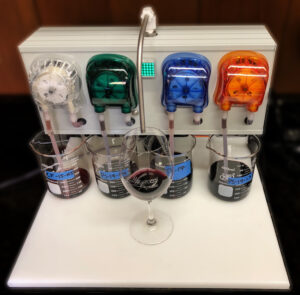
Throw away your pipette, beakers, graduated cylinders and other measuring equipment. Enter in the percentages of the wines you want to add, the app will make sure the total adds up to 100%. Push a button to make the blend.

GOblend is a blending machine for wines. Blending is definitely an art, but there's no reason you can't master it. Blend up to 4 wines with exact accuracy using an app on your phone/pad. Make notes and keep records about the wines and the blends as part of the app.
Take up to 4 wines you think might work well together. Enter the wines into the app providing the aromas, flavors, structure, and overall quality of each wine. Decide on the goals for your final blend. Make a starting blend by adding the percentages of each wine.
Taste the blend and decide which of the 4 wines you want add more of and which one you want less. Tweak the blend to make a new blend, using the app you can make multiple blends in seconds. Keep a record of the blends, rate the blends. Once you have made the final blend you can save the blend in the app and access the records from anywhere in the world.
Why Blend Wines
Blending allows winemakers to create a recognizable house-style; minimize undesirable components; enhance desirable components; improve vintage consistency, and "up-blend" to enhance the wine uniqueness and overall high quality. For example, a winemaker may use blending to enhance a wine's aroma or improve its color. This technique can help balance a wine's acidity, tannins or alcohol levels. Blending also adds complexity to the wine's flavors and textures.
A "blend" can be anything from, for example, 5% Merlot to 95% Cabernet or a Châteauneuf-du-Pape that can be a blend of to a 20 varietals. Historically all have been blended, especially in France. Below are some of the classic blends
BORDEAUX
Arguably one of the most typical blends around the world; the red Bordeaux blend consists of Cabernet Sauvignon, Merlot, Cabernet Franc, Petit Verdot, and Malbec. Flavors vary depending on the area and proportion of grape varietals used in the blend. On the left bank, higher amounts of Cabernet Sauvignon are added, making the wine more structured with higher tannins. On the right bank, wineries will add more Merlot and Cabernet Franc for a softer, more supple wine which might require less aging.
MERITAGE
A Bordeaux-style blend, Meritage blends are created from French varietals grown in the New World wine regions, especially California. A red Meritage blend will generally consist of the classic Bordeaux combination: Cabernet Franc, Malbec, Cabernet Sauvignon, and Merlot (with hints of Carménère and Petit Verdot). Meritage wines can also be a white blend, for example, blending Semillon and Sauvignon Blanc together. Meritage blends are known for their versatility in the sense that they can be enjoyed young but also stand up to aging.
RHONE BLENDS
In the Rhone River Valley of France, it is typical to blend several varietals together, such as Syrah, Grenache, and Mourvedre to make a complex red wine blend. These wines are very interesting and the contribution from each varietal adds complexity, aromas, and flavors to the finished wine.

